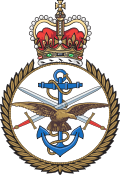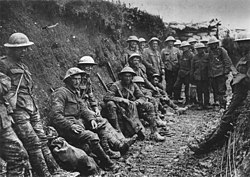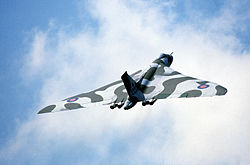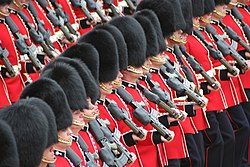British Armed Forces
The British Armed Forces are the military of the United Kingdom. They are officially called His Majesty's Armed Forces and sometimes called the Armed Forces of the Crown.[3] The British Armed Forces are made up of three parts: the British Army, the Royal Navy (including the Royal Marines) and the Royal Air Force.[4]
| British Armed Forces | |
|---|---|
 The tri-service badge | |
| Established | 1707 |
| Parts | |
| Leadership | |
| Commander-in-Chief | Charles III |
| Prime Minister of the United Kingdom (de facto authority) Secretary of State for Defence |
Keir Starmer Rt Hon Grant Shapps MP |
| Chief of the Defence Staff | General Sir Nick Houghton |
| Serving soldiers | |
| Available to be a soldier |
14,607,725 males, age 15–49, 14,028,738 females, age 15–49 |
| Fit to be a soldier |
12,046,268 males, age 15–49, 11,555,893 females, age 15–49 |
| Active employees/soldiers | 150,000 active personnel |
| Reserve personnel | 82,000 regular reserve[N 1] |
| Expenditures | |
| Budget | FY 2013-14: GBP £36.3 billion[1] |
| Percent of GDP | 2.1%[2] |
The Commander-in-Chief of the British Armed Forces is the British monarch.[5] Members of the British Armed Forces must swear allegiance that they will obey the orders of the monarch. Under the constitution of the United Kingdom, the armed forces controlled by the Crown, but because of the 1689 Bill of Rights, the British may not have an army during peacetime unless the British Parliament allows it.[6] However, the British Parliament now passes an Armed Forces Act every five years as a formality. The British Prime Minister is the de facto commander of the British Armed Forces,[7] which are managed by the Ministry of Defence.
The British Armed Forces protect the United Kingdom, the British overseas territories and the Crown dependencies and take part in United Nations peacekeeping missions[8] NATO missions. The most recent wars in which the British Armed Forces have fought are the wars in Afghanistan and Iraq, peacekeeping in Operation Palliser in Sierra Leone, peacekeeping in the Balkans and Cyprus and defending the no-fly zone over Libya. The British Armed Forces have bases in the following places: Ascension Island, Belize, Brunei, Canada, Diego Garcia, the Falkland Islands, Germany, Gibraltar, Kenya, Qatar and the Sovereign Base Areas in Cyprus.[9][10]
The United Kingdom tested its first nuclear weapon in Operation Hurricane in 1952. As of 2012[update], Britain is one of the five recognised nuclear powers and has around 225 nuclear warheads, which are controlled by the Royal Navy.
British Armed Forces Media
A modern reproduction of an 1805 poster commemorating the Battle of Trafalgar
Royal Irish Rifles soldiers at the Battle of the Somme in 1916
The Vulcan Bomber was the mainstay of Britain's airborne nuclear capability for much of the Cold War.
Then Commander-in-Chief Queen Elizabeth II riding Burmese at the 1986 Trooping the Colour ceremony
The Ministry of Defence building at Whitehall, Westminster, London
Related pages
Notes
- ↑ There were 181,720 regular reserves from all services of the British Armed Forces. 33,380 were in the Royal Air Force (2007), 121,820 were in the Army (2007) and 26,520 were in the Royal Navy (2002).
References
- ↑ HM Treasury Archived 2013-04-25 at the Wayback Machine 2013 Budget 56.1 billion USD ranked 6th, 2018
- ↑ "The 15 countries with the highest military expenditure in 2013 (table)". Stockholm International Peace Research Institute. Archived from the original (PDF) on 4 January 2015. Retrieved 14 April 2014.
- ↑ Armed Forces Act 1976, Arrangement of Sections Archived 2009-02-21 at the Wayback Machine, raf.mod.uk
- ↑ "Ministry of Defence". Ministry of Defence. Retrieved 21 February 2012.
- ↑ "The Queen and the Armed Forces". The Royal Family. 9 January 2017. Retrieved 15 November 2022.
- ↑ "Bill of Rights 1689". Wikisource. Retrieved 5 August 2011.
- ↑ "U.S. Relations With United Kingdom". United States Department of State. Retrieved 15 November 2022.
- ↑ The Mission of the Armed Forces, armedforces.co.uk
- ↑ Permanent Joint Operating Bases Archived 2007-06-07 at the Wayback Machine, northwood.mod.uk
- ↑ House of Commons Hansard, publications.parliament.uk








